Attached files
| file | filename |
|---|---|
| 8-K - 8-K - MERCER INTERNATIONAL INC. | o62078e8vk.htm |
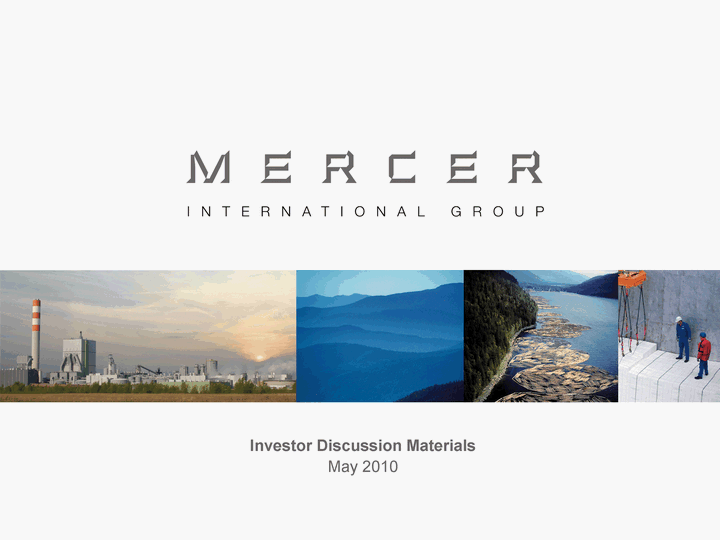
| Investor Discussion Materials May 2010 |
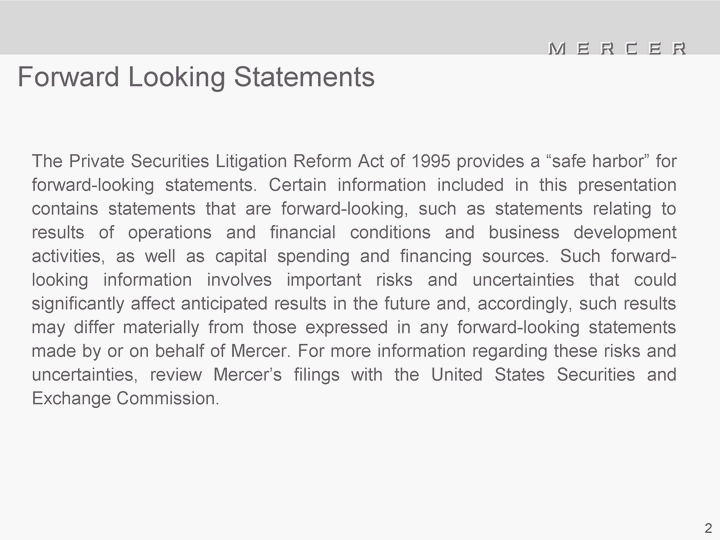
| The Private Securities Litigation Reform Act of 1995 provides a "safe harbor" for forward-looking statements. Certain information included in this presentation contains statements that are forward-looking, such as statements relating to results of operations and financial conditions and business development activities, as well as capital spending and financing sources. Such forward- looking information involves important risks and uncertainties that could significantly affect anticipated results in the future and, accordingly, such results may differ materially from those expressed in any forward-looking statements made by or on behalf of Mercer. For more information regarding these risks and uncertainties, review Mercer's filings with the United States Securities and Exchange Commission. Forward Looking Statements |

| Introduction |
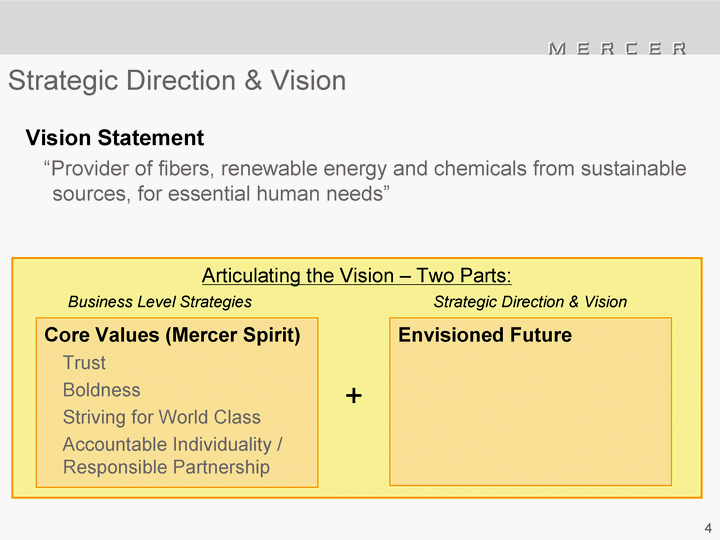
| Articulating the Vision - Two Parts: Vision Statement "Provider of fibers, renewable energy and chemicals from sustainable sources, for essential human needs" Strategic Direction & Vision Core Values (Mercer Spirit) Trust Boldness Striving for World Class Accountable Individuality / Responsible Partnership Envisioned Future + Business Level Strategies Strategic Direction & Vision |
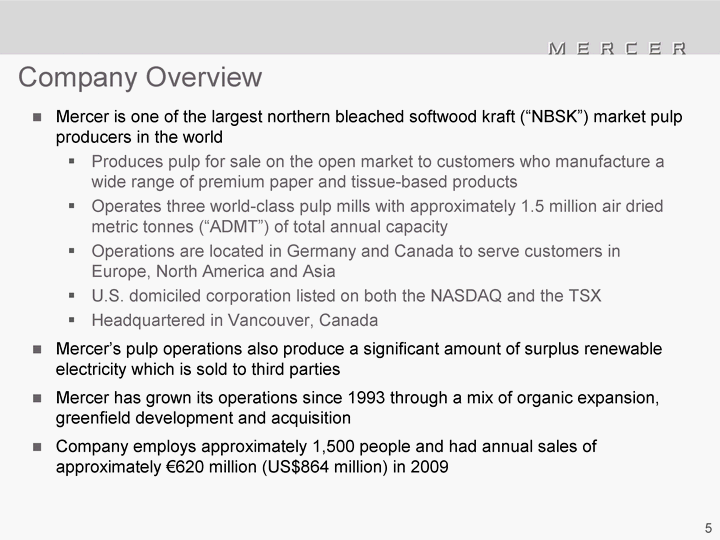
| Company Overview Mercer is one of the largest northern bleached softwood kraft ("NBSK") market pulp producers in the world Produces pulp for sale on the open market to customers who manufacture a wide range of premium paper and tissue-based products Operates three world-class pulp mills with approximately 1.5 million air dried metric tonnes ("ADMT") of total annual capacity Operations are located in Germany and Canada to serve customers in Europe, North America and Asia U.S. domiciled corporation listed on both the NASDAQ and the TSX Headquartered in Vancouver, Canada Mercer's pulp operations also produce a significant amount of surplus renewable electricity which is sold to third parties Mercer has grown its operations since 1993 through a mix of organic expansion, greenfield development and acquisition Company employs approximately 1,500 people and had annual sales of approximately €620 million (US$864 million) in 2009 |
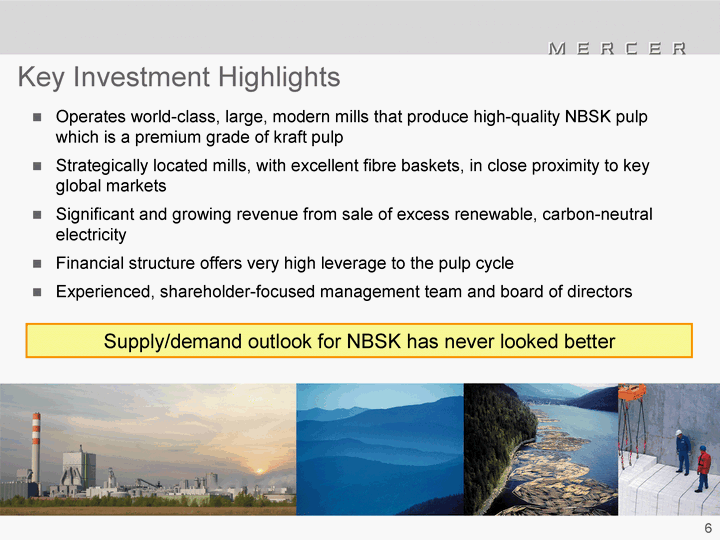
| Key Investment Highlights Operates world-class, large, modern mills that produce high-quality NBSK pulp which is a premium grade of kraft pulp Strategically located mills, with excellent fibre baskets, in close proximity to key global markets Significant and growing revenue from sale of excess renewable, carbon-neutral electricity Financial structure offers very high leverage to the pulp cycle Experienced, shareholder-focused management team and board of directors Supply/demand outlook for NBSK has never looked better |
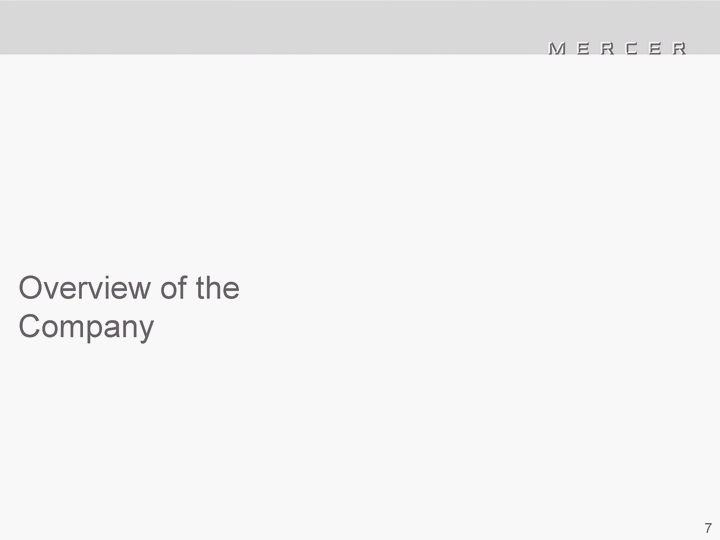
| Overview of the Company |
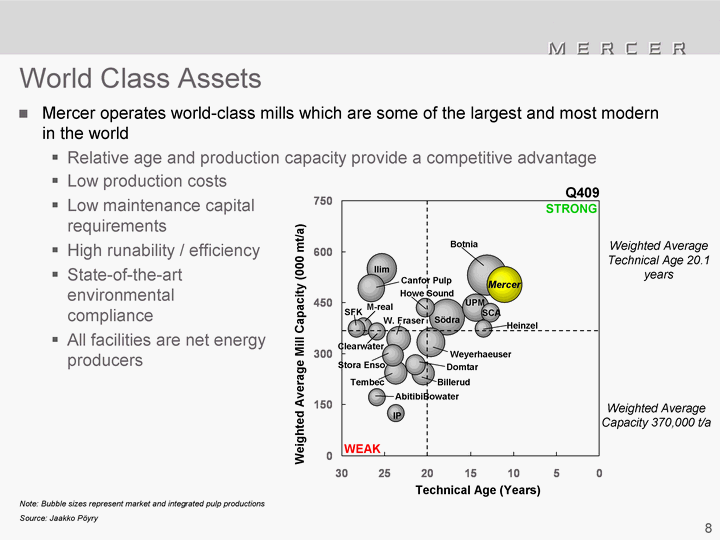
| World Class Assets Mercer operates world-class mills which are some of the largest and most modern in the world Relative age and production capacity provide a competitive advantage Note: Bubble sizes represent market and integrated pulp productions Source: Jaakko Poyry Low production costs Low maintenance capital requirements High runability / efficiency State-of-the-art environmental compliance All facilities are net energy producers X axis Company Comment Botnia Size 1 Sodra Size 2 Mercer Size 3 Ilim Pulp Size 4 Weyerhaeuser Size 5 Canfor Size 6 UPM Size 7 West Fraser Size 8 Billerud Size 9 Tembec Size 10 Stora Enso Size 11 Domtar Size 12 Howe Sound Size 13 SCA Size 14 M-real Size 15 Heinzel Size 16 SFK Pulp Size 17 Clearwater Size 18 AbitibiBowater Size 19 International Paper Size 20 Dots for lines W.Avg Cap 30 Horisontal line 370 0 0 Horisontal line 370 0 20.1 Vertical Line 800 0 20.1 Vertical Line 0 0 Units 13.1 Botnia 531.1 1865 17.7 Sodra 407.1 1455 11 Mercer 504 1420 25.3 Ilim Pulp 549.9 995 19.6 Weyerhaeuser 333.9 980 26.6 Canfor 493.6 900 14.4 UPM 435.1 870 23.4 West Fraser 345.1 690 20.5 Billerud 241.6 645 23.7 Tembec 244.2 590 24 Stora Enso 295.1 525 21.4 Domtar 268 490 20.3 Howe Sound 435 435 12.7 SCA 420 420 27.5 M-real 380 380 13.5 Heinzel 375 375 28.3 SFK Pulp 375 375 25.9 Potlatch 365 365 25.9 AbitibiBowater 172.5 345 23.7 International Paper 124.6 335 Technical Age (Years) Weighted Average Technical Age 20.1 years Weighted Average Mill Capacity (000 mt/a) Weighted Average Capacity 370,000 t/a Q409 STRONG Sodra Weyerhaeuser Tembec SCA W. Fraser Ilim Domtar Mercer Canfor Pulp Botnia UPM Howe Sound Heinzel Billerud IP Stora Enso Clearwater AbitibiBowater SFK M-real WEAK |

| Strategic Locations Mercer's strategic locations in Germany and Western Canada position the company well to serve customers in Europe, North America and Asia In particular, China - the world's fastest growing pulp import market - and Germany - the largest European pulp import market Celgar (B.C., Canada) 500,000 ADMT ^ United States Stendal (Germany) 645,000 ADMT Rosenthal (Germany) 330,000 ADMT ^ ^ Indonesia China Thailand Middle East Europe Japan |
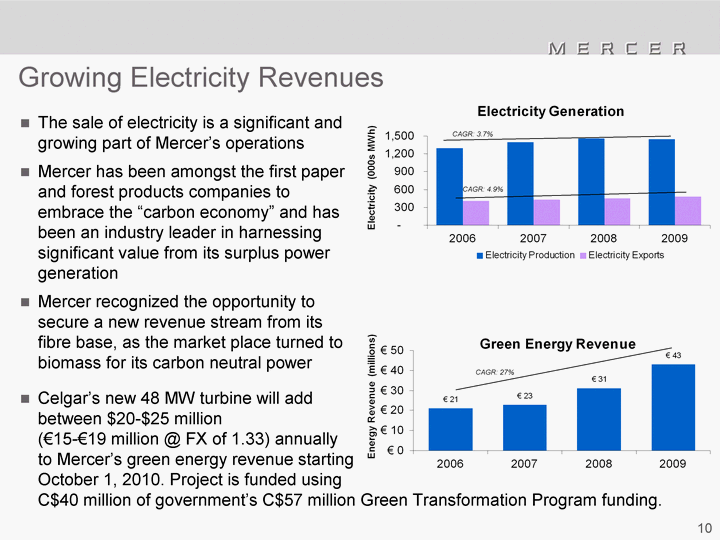
| Growing Electricity Revenues The sale of electricity is a significant and growing part of Mercer's operations Mercer has been amongst the first paper and forest products companies to embrace the "carbon economy" and has been an industry leader in harnessing significant value from its surplus power generation Mercer recognized the opportunity to secure a new revenue stream from its fibre base, as the market place turned to biomass for its carbon neutral power CAGR: 27% CAGR: 3.7% CAGR: 4.9% Celgar's new 48 MW turbine will add between $20-$25 million (€15-€19 million @ FX of 1.33) annually to Mercer's green energy revenue starting October 1, 2010. Project is funded using C$40 million of government's C$57 million Green Transformation Program funding. |
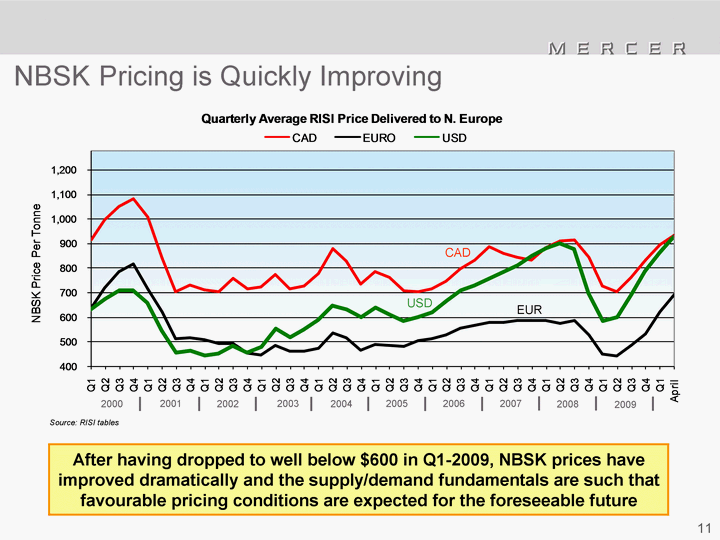
| NBSK Pricing is Quickly Improving After having dropped to well below $600 in Q1-2009, NBSK prices have improved dramatically and the supply/demand fundamentals are such that favourable pricing conditions are expected for the foreseeable future Source: RISI tables 2004 2000 2002 2001 2003 2005 2006 2007 CAD USD EUR 2008 2009 |

| The Outlook for NBSK has Never Looked Better 1 Hawkins Wright - Defining the China Market (October 2009) Flat supply, growing demand and positive exposure to the effects of climate change create an excellent operating environment for Mercer for the foreseeable future NBSK is a great business to be in now and in the future Demand for NBSK continues to increase as global production of tissue and specialty papers grows, emerging markets develop, and standards of living improve For example, in China, production volumes of fine paper and pulp based tissue are forecasted to grow at average annual rates of 13% and 10% from 2009 to 2013, respectively 1 Given the trend towards faster production rates, increased recycled content, and lower basis weights, NBSK will always be needed because of its strength Supply of softwood pulp is going to remain flat or decrease slightly New capacity projects are overwhelmingly HW and the increase in SW supply from announced Ilim Bratsk mill opening in 2012 will be more than offset by recent SW capacity closures Mercer is extremely well positioned to benefit from climate change through opportunities such as favourable green energy rates and government incentives Climate change is making the cost curve of pulp and paper steeper, significantly disadvantaging inefficient and environmentally unsound operations and benefitting world class operations, such as Mercer's |
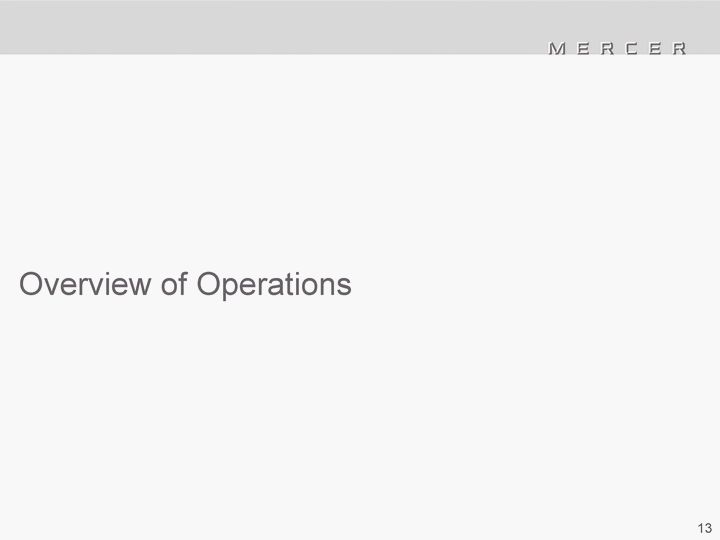
| Overview of Operations |

| Mercer conducts operations through three subsidiaries; two in Germany and one in Canada Mercer operates the only two NBSK pulp mills in Germany - Europe's largest market for NBSK pulp - and one of the largest, most modern pulp mills in North America Corporate Overview Rosenthal (Germany) Celgar (British Columbia) Stendal (1) (Germany) 74.9% Restricted Group 100% 100% (1) Mercer reports the Stendal mill separately from Rosenthal, Celgar and Mercer International Inc., (together the "Restricted Group") as the debt at Stendal is non-recourse to Mercer's other operations (2) Pro forma installation of second turbine in Q4 2010 500,000 ADMT 100 MW Capacity (2) 330,000 ADMT 57 MW Capacity 645,000 ADMT 102 MW Capacity |
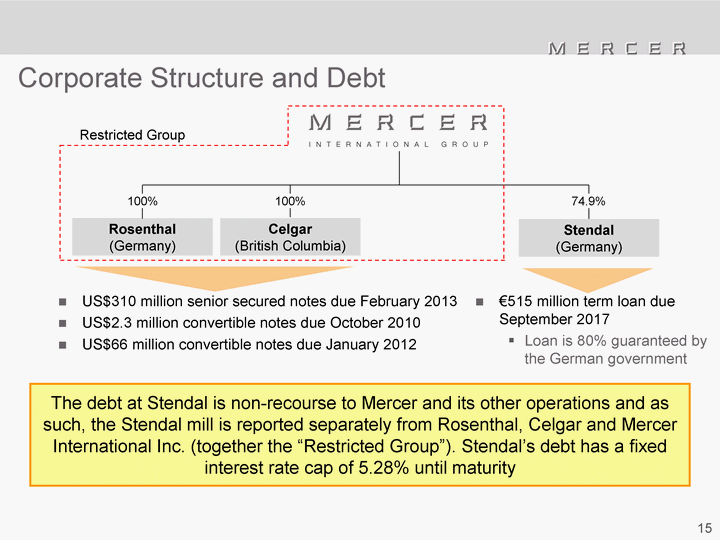
| Corporate Structure and Debt Rosenthal (Germany) Celgar (British Columbia) Stendal (Germany) 74.9% US$310 million senior secured notes due February 2013 US$2.3 million convertible notes due October 2010 US$66 million convertible notes due January 2012 €515 million term loan due September 2017 Loan is 80% guaranteed by the German government Restricted Group 100% 100% The debt at Stendal is non-recourse to Mercer and its other operations and as such, the Stendal mill is reported separately from Rosenthal, Celgar and Mercer International Inc. (together the "Restricted Group"). Stendal's debt has a fixed interest rate cap of 5.28% until maturity |
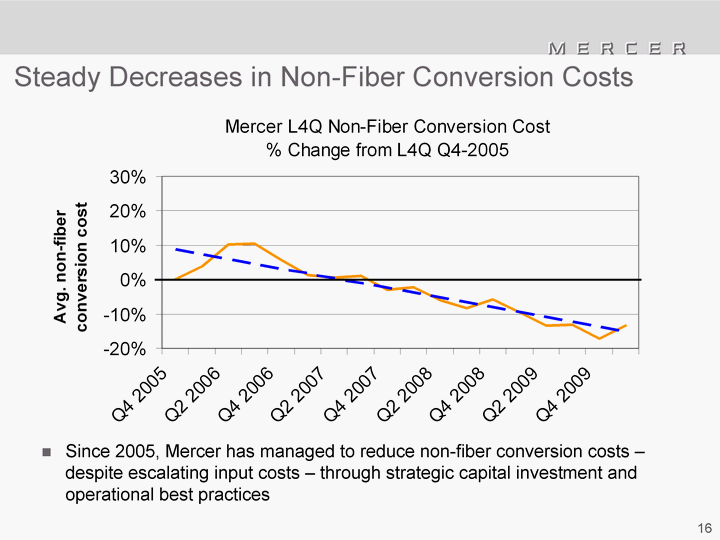
| Steady Decreases in Non-Fiber Conversion Costs Since 2005, Mercer has managed to reduce non-fiber conversion costs - despite escalating input costs - through strategic capital investment and operational best practices |
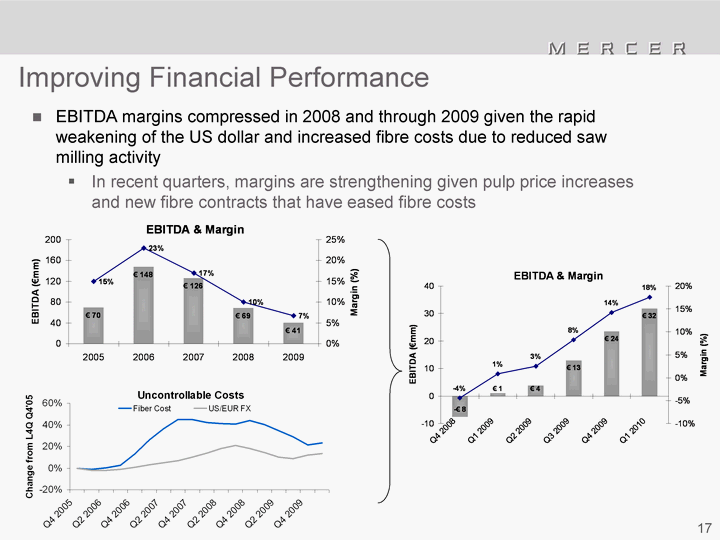
| EBITDA margins compressed in 2008 and through 2009 given the rapid weakening of the US dollar and increased fibre costs due to reduced saw milling activity In recent quarters, margins are strengthening given pulp price increases and new fibre contracts that have eased fibre costs Improving Financial Performance |
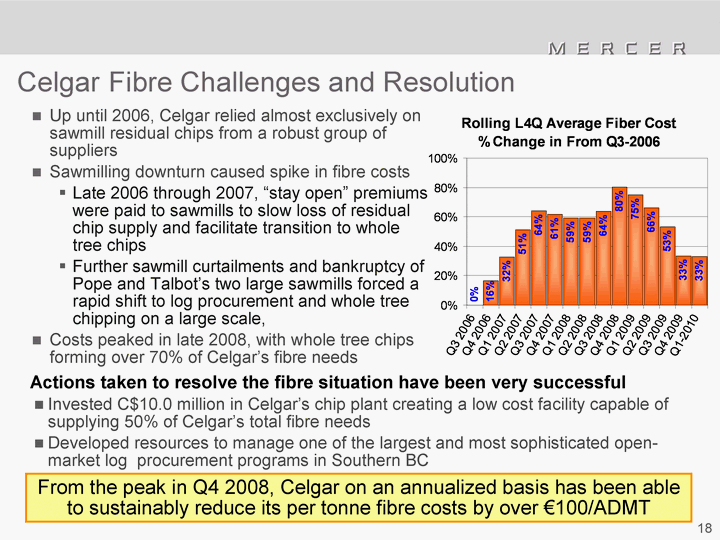
| Up until 2006, Celgar relied almost exclusively on sawmill residual chips from a robust group of suppliers Sawmilling downturn caused spike in fibre costs Late 2006 through 2007, "stay open" premiums were paid to sawmills to slow loss of residual chip supply and facilitate transition to whole tree chips Further sawmill curtailments and bankruptcy of Pope and Talbot's two large sawmills forced a rapid shift to log procurement and whole tree chipping on a large scale, Costs peaked in late 2008, with whole tree chips forming over 70% of Celgar's fibre needs From the peak in Q4 2008, Celgar on an annualized basis has been able to sustainably reduce its per tonne fibre costs by over €100/ADMT Celgar Fibre Challenges and Resolution Actions taken to resolve the fibre situation have been very successful Invested C$10.0 million in Celgar's chip plant creating a low cost facility capable of supplying 50% of Celgar's total fibre needs Developed resources to manage one of the largest and most sophisticated open- market log procurement programs in Southern BC |
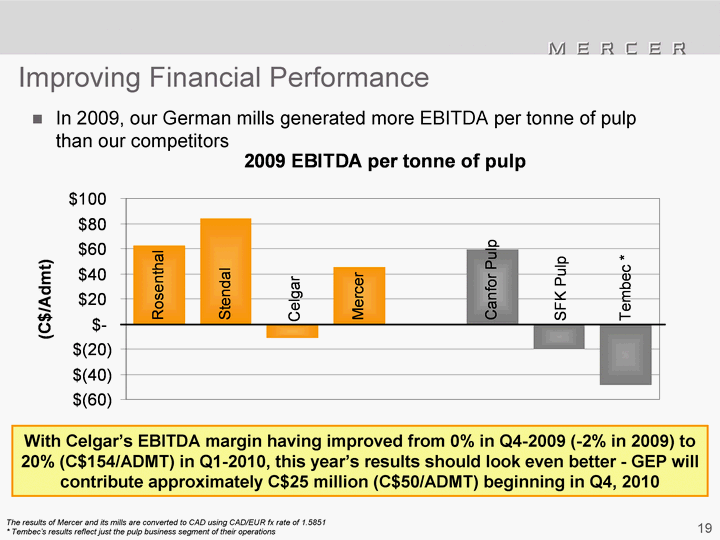
| In 2009, our German mills generated more EBITDA per tonne of pulp than our competitors Improving Financial Performance The results of Mercer and its mills are converted to CAD using CAD/EUR fx rate of 1.5851 * Tembec's results reflect just the pulp business segment of their operations With Celgar's EBITDA margin having improved from 0% in Q4-2009 (-2% in 2009) to 20% (C$154/ADMT) in Q1-2010, this year's results should look even better - GEP will contribute approximately C$25 million (C$50/ADMT) beginning in Q4, 2010 |
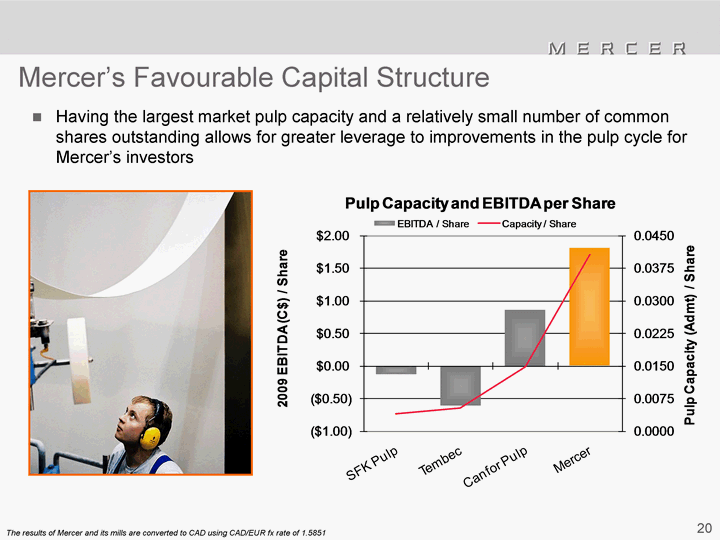
| Having the largest market pulp capacity and a relatively small number of common shares outstanding allows for greater leverage to improvements in the pulp cycle for Mercer's investors Mercer's Favourable Capital Structure The results of Mercer and its mills are converted to CAD using CAD/EUR fx rate of 1.5851 |
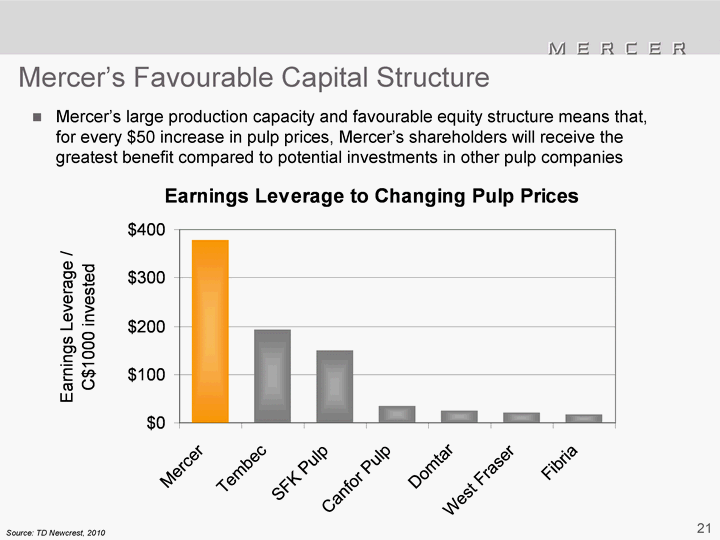
| Mercer's large production capacity and favourable equity structure means that, for every $50 increase in pulp prices, Mercer's shareholders will receive the greatest benefit compared to potential investments in other pulp companies Mercer's Favourable Capital Structure Source: TD Newcrest, 2010 |

| Mercer has a well-diversified and stable sales mix Sizeable leverage to European markets in particular Germany - world's largest NBSK market Significant exposure to China - the world's fastest growing pulp market Growing exposure to tissue / hygiene end uses which have a higher growth rate for NBSK than printing and writing papers Segmented Sales Europe, 53% 2009 Sales by End-Use 2009 Sales by Geography Other countries 2% |
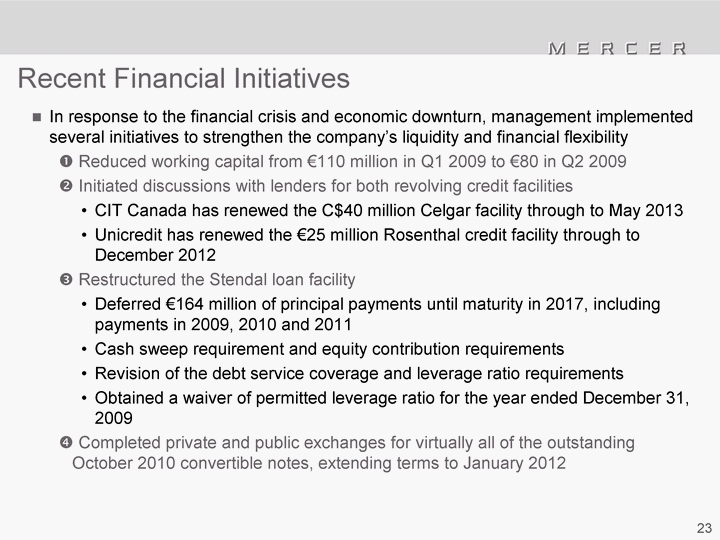
| Recent Financial Initiatives In response to the financial crisis and economic downturn, management implemented several initiatives to strengthen the company's liquidity and financial flexibility ? Reduced working capital from €110 million in Q1 2009 to €80 in Q2 2009 ? Initiated discussions with lenders for both revolving credit facilities CIT Canada has renewed the C$40 million Celgar facility through to May 2013 Unicredit has renewed the €25 million Rosenthal credit facility through to December 2012 ? Restructured the Stendal loan facility Deferred €164 million of principal payments until maturity in 2017, including payments in 2009, 2010 and 2011 Cash sweep requirement and equity contribution requirements Revision of the debt service coverage and leverage ratio requirements Obtained a waiver of permitted leverage ratio for the year ended December 31, 2009 ? Completed private and public exchanges for virtually all of the outstanding October 2010 convertible notes, extending terms to January 2012 |
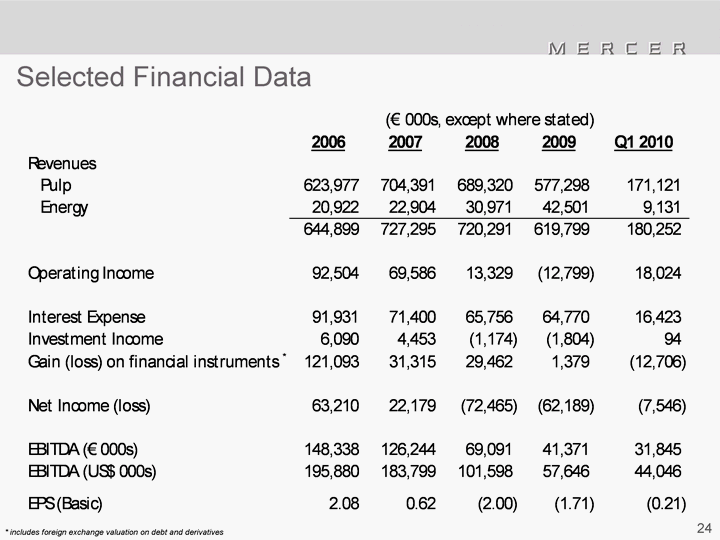
| Selected Financial Data * includes foreign exchange valuation on debt and derivatives |
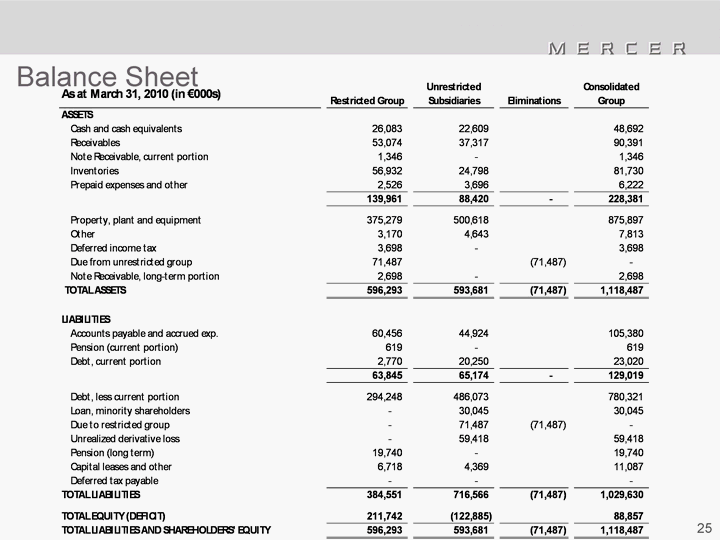
| Balance Sheet |
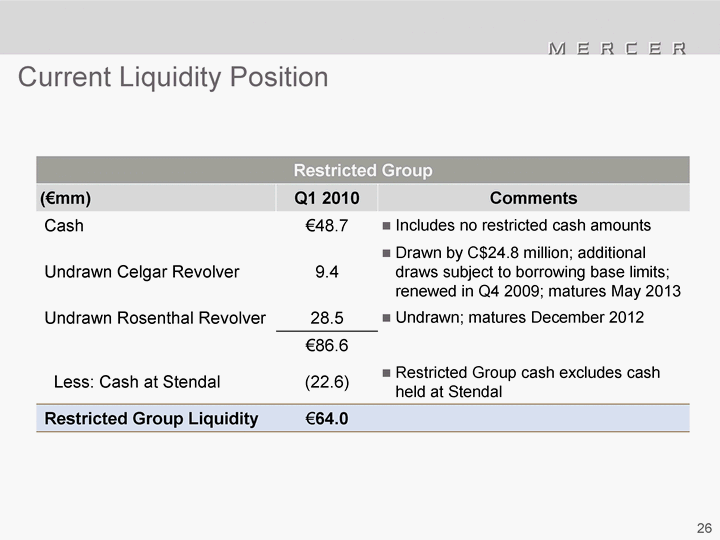
| Current Liquidity Position Restricted Group Restricted Group Restricted Group (€mm) Q1 2010 Comments Cash €48.7 Includes no restricted cash amounts Undrawn Celgar Revolver 9.4 Drawn by C$24.8 million; additional draws subject to borrowing base limits; renewed in Q4 2009; matures May 2013 Undrawn Rosenthal Revolver 28.5 Undrawn; matures December 2012 €86.6 Less: Cash at Stendal (22.6) Restricted Group cash excludes cash held at Stendal Restricted Group Liquidity €64.0 |

| Mercer's Share Price is Significantly Discounted Mercer's Adjusted Book Value Per Share Mercer's Adjusted Book Value Per Share Mercer's Adjusted Book Value Per Share Shareholder's Equity (1) €123.5 Add: Government Grants Received (2) €284.0 "Adjusted" Book Value €407.5 Adjusted Book Value Per Share (US$) $15.11 Mar. 31, 2010 Share Price (US$) $5.27 Discount 65% Mercer's current market value represents a significant discount to the "adjusted" book value, which reflects the net €284 million in German and Canadian government grants as equity (1) As at March 31, 2010 (2) Total government grants received, less amortization, as at March 31, 2010 Current market prices have Mercer shares trading at 65% below their book value |

| Investment Highlights |
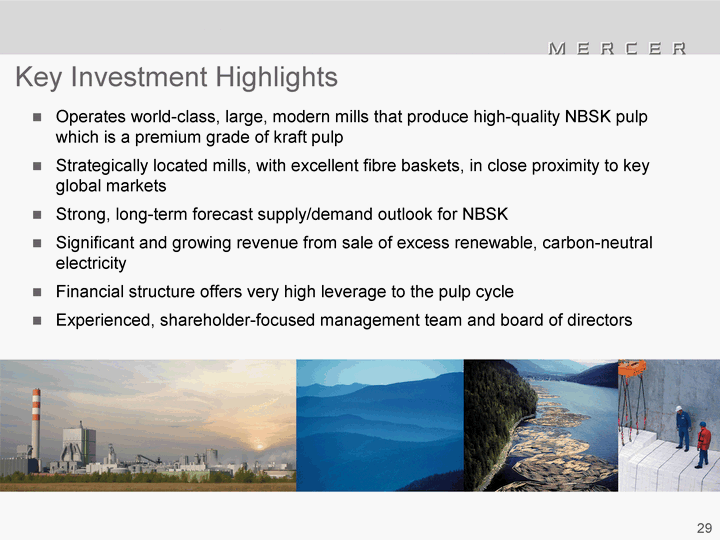
| Key Investment Highlights Operates world-class, large, modern mills that produce high-quality NBSK pulp which is a premium grade of kraft pulp Strategically located mills, with excellent fibre baskets, in close proximity to key global markets Strong, long-term forecast supply/demand outlook for NBSK Significant and growing revenue from sale of excess renewable, carbon-neutral electricity Financial structure offers very high leverage to the pulp cycle Experienced, shareholder-focused management team and board of directors |

| Appendix |
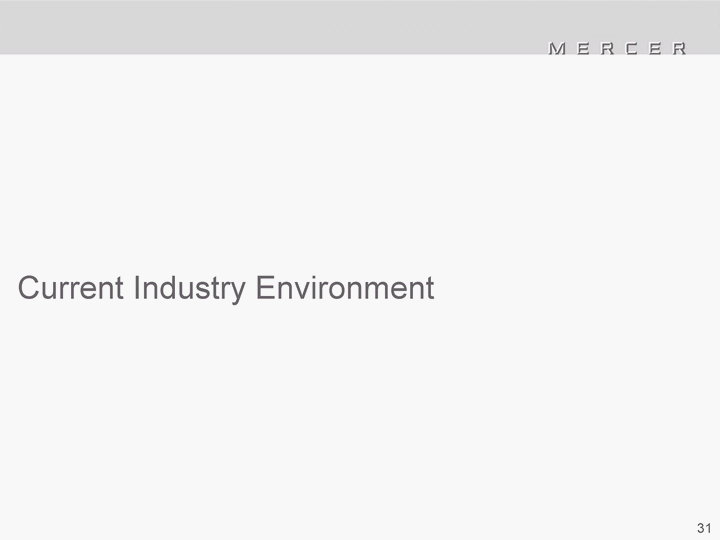
| Current Industry Environment |
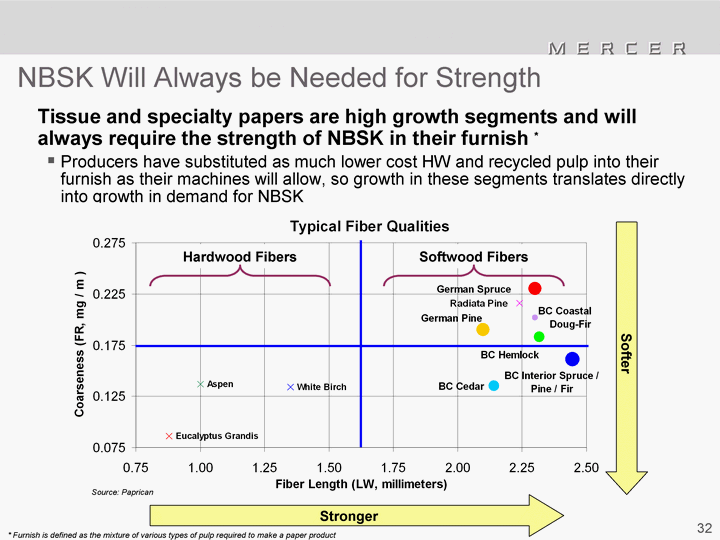
| NBSK Will Always be Needed for Strength Tissue and specialty papers are high growth segments and will always require the strength of NBSK in their furnish * Producers have substituted as much lower cost HW and recycled pulp into their furnish as their machines will allow, so growth in these segments translates directly into growth in demand for NBSK Stronger Softer Hardwood Fibers Softwood Fibers Source: Paprican * Furnish is defined as the mixture of various types of pulp required to make a paper product |
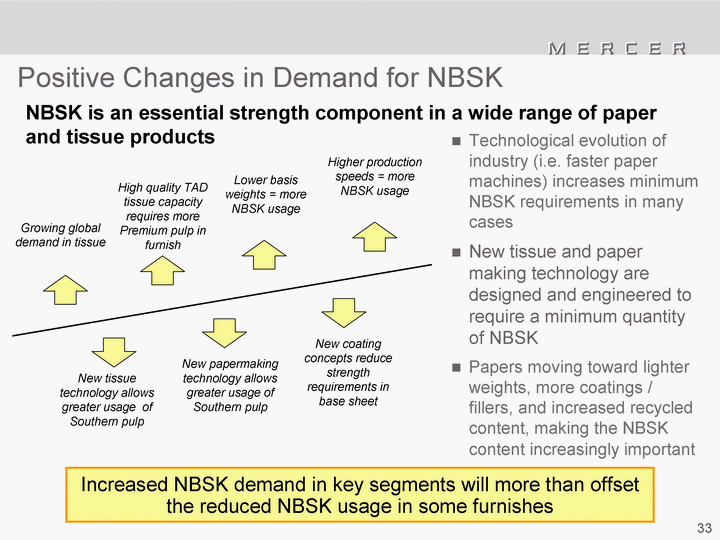
| Growing global demand in tissue High quality TAD tissue capacity requires more Premium pulp in furnish Lower basis weights = more NBSK usage Higher production speeds = more NBSK usage New tissue technology allows greater usage of Southern pulp New papermaking technology allows greater usage of Southern pulp New coating concepts reduce strength requirements in base sheet Increased NBSK demand in key segments will more than offset the reduced NBSK usage in some furnishes Positive Changes in Demand for NBSK Technological evolution of industry (i.e. faster paper machines) increases minimum NBSK requirements in many cases New tissue and paper making technology are designed and engineered to require a minimum quantity of NBSK Papers moving toward lighter weights, more coatings / fillers, and increased recycled content, making the NBSK content increasingly important NBSK is an essential strength component in a wide range of paper and tissue products |

| Tissue is the Highest Growth Segment Since 2000, global tissue output has grown at an average annual rate of 3.9% and shows no signs of slowing down As populations age, global standards of living improve, and health and hygiene become larger concerns, demand for tissue - and thus NBSK - will continue to grow Source: TerraChoice Market Services Inc., FAO, PPI Annual Review 2000 - 2009 Average annual growth rate = 3.9% |
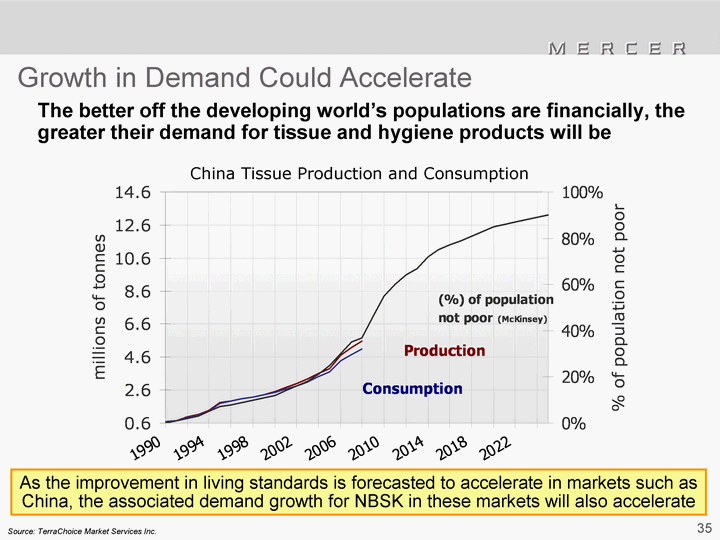
| Growth in Demand Could Accelerate The better off the developing world's populations are financially, the greater their demand for tissue and hygiene products will be Source: TerraChoice Market Services Inc. As the improvement in living standards is forecasted to accelerate in markets such as China, the associated demand growth for NBSK in these markets will also accelerate China Tissue Production and Consumption |
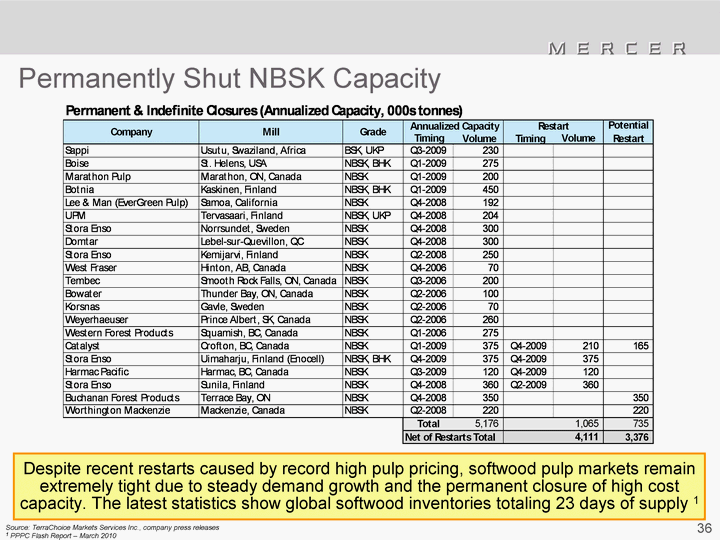
| Source: TerraChoice Markets Services Inc., company press releases 1 PPPC Flash Report - March 2010 Permanently Shut NBSK Capacity Despite recent restarts caused by record high pulp pricing, softwood pulp markets remain extremely tight due to steady demand growth and the permanent closure of high cost capacity. The latest statistics show global softwood inventories totaling 23 days of supply 1 |
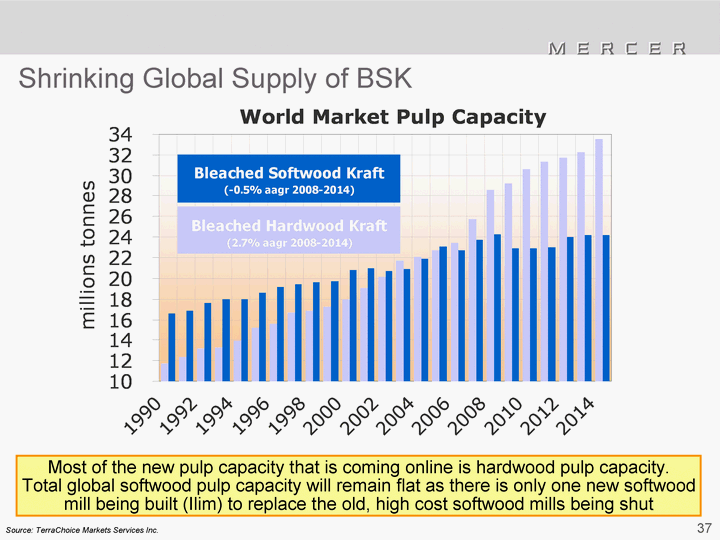
| Shrinking Global Supply of BSK Source: TerraChoice Markets Services Inc. Most of the new pulp capacity that is coming online is hardwood pulp capacity. Total global softwood pulp capacity will remain flat as there is only one new softwood mill being built (Ilim) to replace the old, high cost softwood mills being shut |
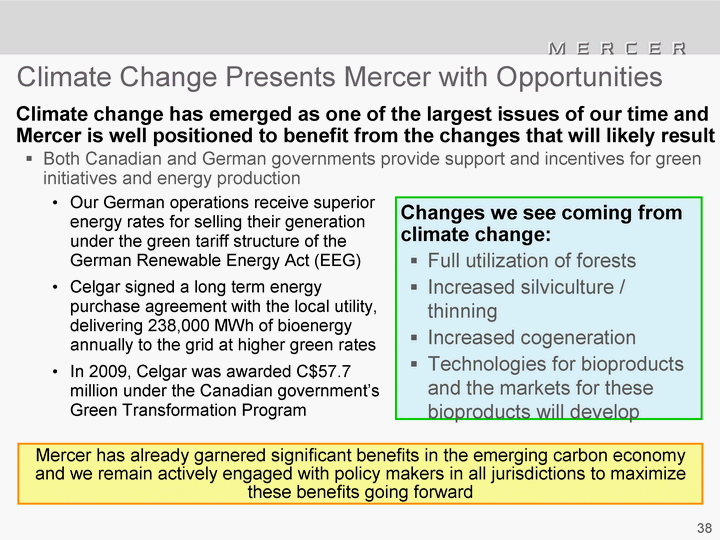
| Climate Change Presents Mercer with Opportunities Climate change has emerged as one of the largest issues of our time and Mercer is well positioned to benefit from the changes that will likely result Both Canadian and German governments provide support and incentives for green initiatives and energy production Our German operations receive superior energy rates for selling their generation under the green tariff structure of the German Renewable Energy Act (EEG) Celgar signed a long term energy purchase agreement with the local utility, delivering 238,000 MWh of bioenergy annually to the grid at higher green rates In 2009, Celgar was awarded C$57.7 million under the Canadian government's Green Transformation Program Mercer has already garnered significant benefits in the emerging carbon economy and we remain actively engaged with policy makers in all jurisdictions to maximize these benefits going forward Changes we see coming from climate change: Full utilization of forests Increased silviculture / thinning Increased cogeneration Technologies for bioproducts and the markets for these bioproducts will develop |
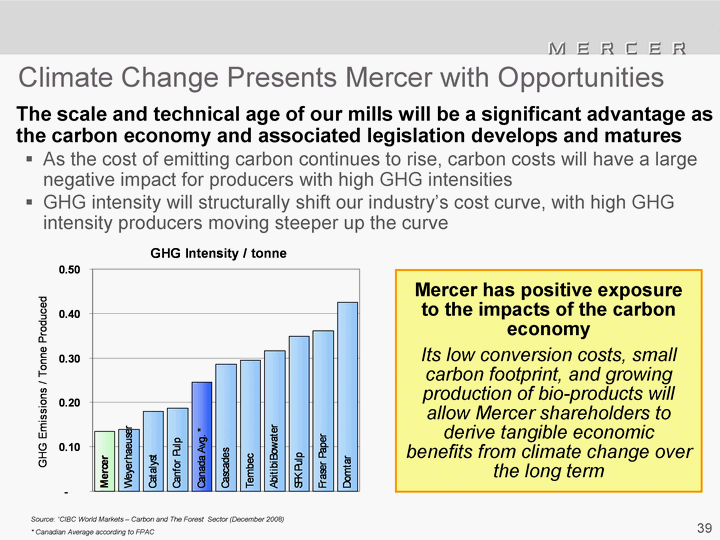
| The scale and technical age of our mills will be a significant advantage as the carbon economy and associated legislation develops and matures As the cost of emitting carbon continues to rise, carbon costs will have a large negative impact for producers with high GHG intensities GHG intensity will structurally shift our industry's cost curve, with high GHG intensity producers moving steeper up the curve Climate Change Presents Mercer with Opportunities Source: "CIBC World Markets - Carbon and The Forest Sector (December 2008) * Canadian Average according to FPAC Mercer has positive exposure to the impacts of the carbon economy Its low conversion costs, small carbon footprint, and growing production of bio-products will allow Mercer shareholders to derive tangible economic benefits from climate change over the long term |

| Stendal Mill Historical Perspective - 2005 Greenfield mill constructed by Mercer, completed in Q3-2004 Project had a €1 Billion capital cost Was 63.6% Mercer owned Built with € 275 million in German government grants 80% of debt guaranteed by government Expected to achieve 80% of its 552,000 ADMT design capacity in its first year Stendal is the most modern NBSK mill in the world and, with its large operating scale, delivers a very low non-fibre production cost |
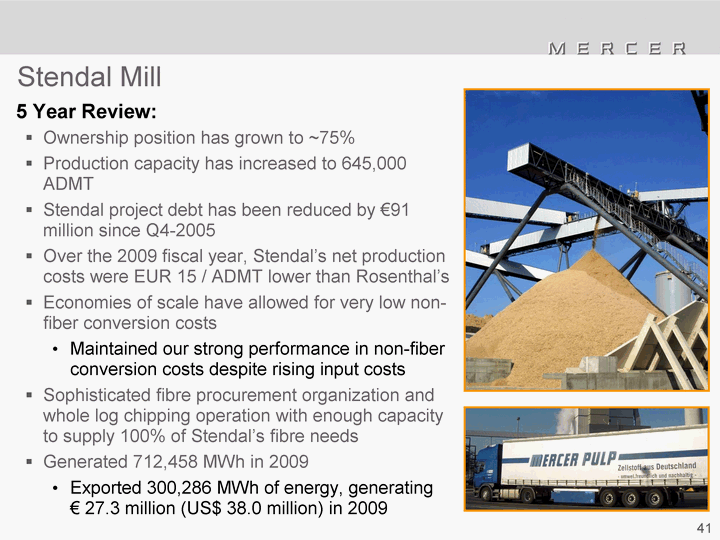
| Stendal Mill 5 Year Review: Ownership position has grown to ~75% Production capacity has increased to 645,000 ADMT Stendal project debt has been reduced by €91 million since Q4-2005 Over the 2009 fiscal year, Stendal's net production costs were EUR 15 / ADMT lower than Rosenthal's Economies of scale have allowed for very low non- fiber conversion costs Maintained our strong performance in non-fiber conversion costs despite rising input costs Sophisticated fibre procurement organization and whole log chipping operation with enough capacity to supply 100% of Stendal's fibre needs Generated 712,458 MWh in 2009 Exported 300,286 MWh of energy, generating € 27.3 million (US$ 38.0 million) in 2009 |
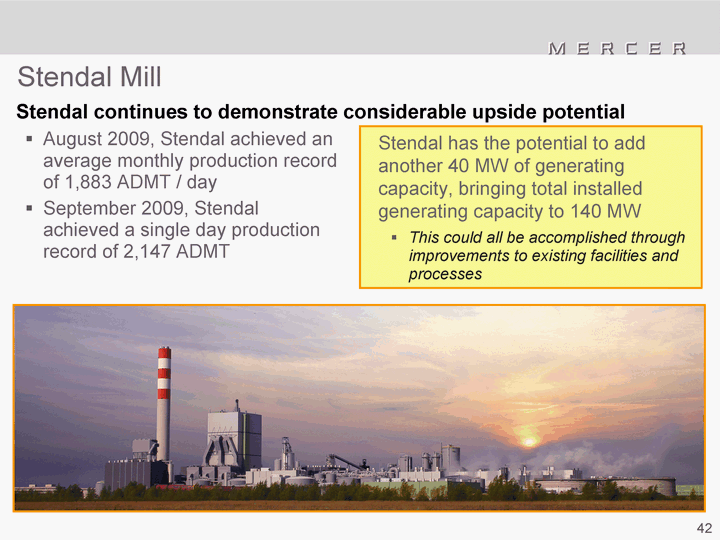
| Stendal has the potential to add another 40 MW of generating capacity, bringing total installed generating capacity to 140 MW Stendal Mill Stendal continues to demonstrate considerable upside potential August 2009, Stendal achieved an average monthly production record of 1,883 ADMT / day September 2009, Stendal achieved a single day production record of 2,147 ADMT This could all be accomplished through improvements to existing facilities and processes |

| Restricted Group - Rosenthal Mill Built in 1999, the mill is modern, efficient, and ISO 9002 certified NBSK pulp capacity of 330,000 ADMT / year 2nd largest biomass power plant in Germany (next to Stendal) with electricity generating capacity of 57 MW € 14.5 million in revenue from electricity sales in 2009 (US$20.3 million) Strategically located in central Europe, Rosenthal offers a superior value proposition to customers Proximity to key European markets allows customers to operate on just in time inventory, saving them money and making Rosenthal the preferred supplier Rosenthal has a strong fibre supply as a result of: A strong sawmill industry that operates nearby Maintaining a very sophisticated log procurement organization and a large capacity whole log chipping operation |
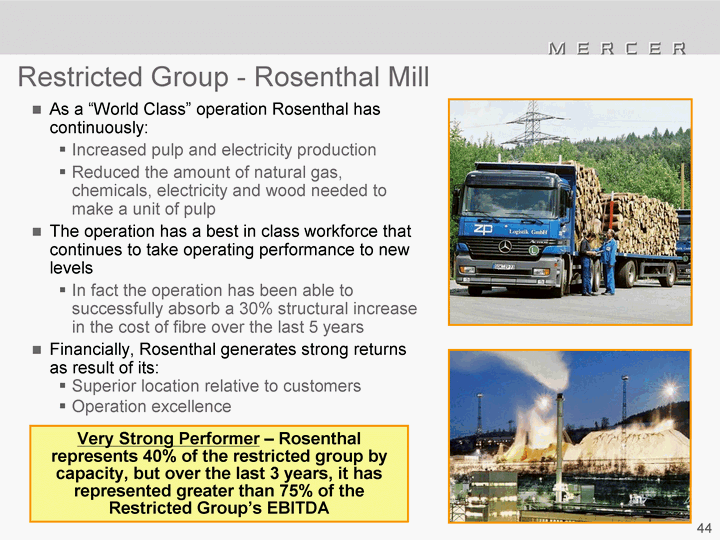
| As a "World Class" operation Rosenthal has continuously: Increased pulp and electricity production Reduced the amount of natural gas, chemicals, electricity and wood needed to make a unit of pulp The operation has a best in class workforce that continues to take operating performance to new levels In fact the operation has been able to successfully absorb a 30% structural increase in the cost of fibre over the last 5 years Financially, Rosenthal generates strong returns as result of its: Superior location relative to customers Operation excellence Very Strong Performer - Rosenthal represents 40% of the restricted group by capacity, but over the last 3 years, it has represented greater than 75% of the Restricted Group's EBITDA Restricted Group - Rosenthal Mill |
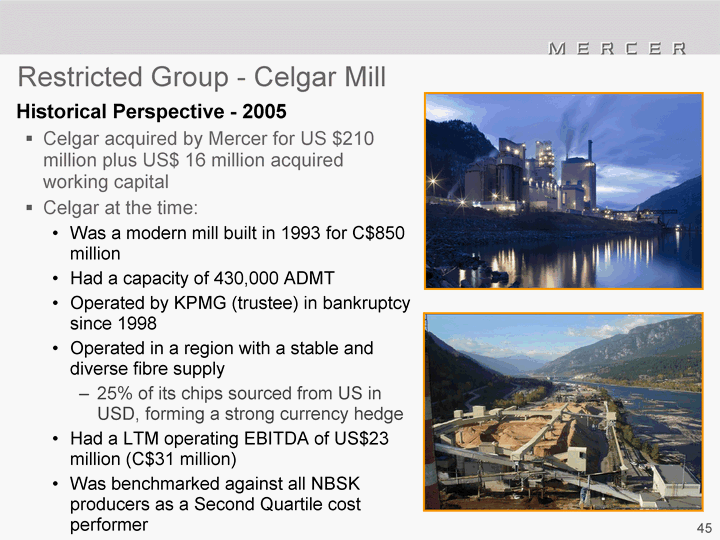
| Restricted Group - Celgar Mill Historical Perspective - 2005 Celgar acquired by Mercer for US $210 million plus US$ 16 million acquired working capital Celgar at the time: Was a modern mill built in 1993 for C$850 million Had a capacity of 430,000 ADMT Operated by KPMG (trustee) in bankruptcy since 1998 Operated in a region with a stable and diverse fibre supply 25% of its chips sourced from US in USD, forming a strong currency hedge Had a LTM operating EBITDA of US$23 million (C$31 million) Was benchmarked against all NBSK producers as a Second Quartile cost performer |
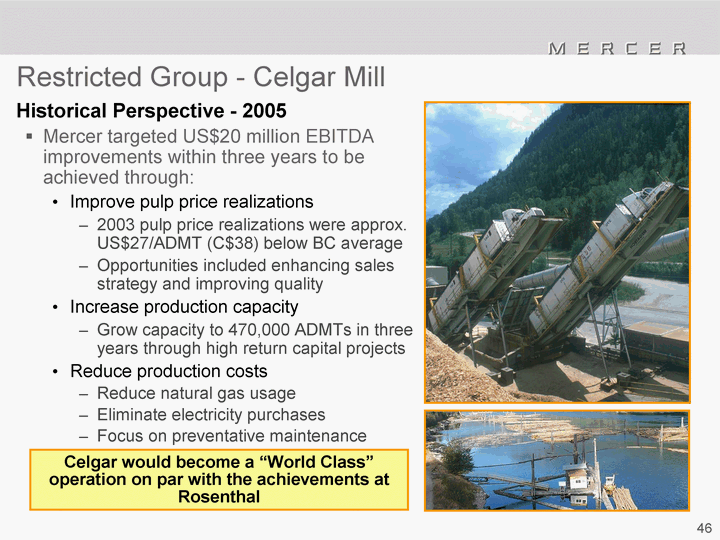
| Restricted Group - Celgar Mill Historical Perspective - 2005 Mercer targeted US$20 million EBITDA improvements within three years to be achieved through: Improve pulp price realizations 2003 pulp price realizations were approx. US$27/ADMT (C$38) below BC average Opportunities included enhancing sales strategy and improving quality Increase production capacity Grow capacity to 470,000 ADMTs in three years through high return capital projects Reduce production costs Reduce natural gas usage Eliminate electricity purchases Focus on preventative maintenance Celgar would become a "World Class" operation on par with the achievements at Rosenthal |
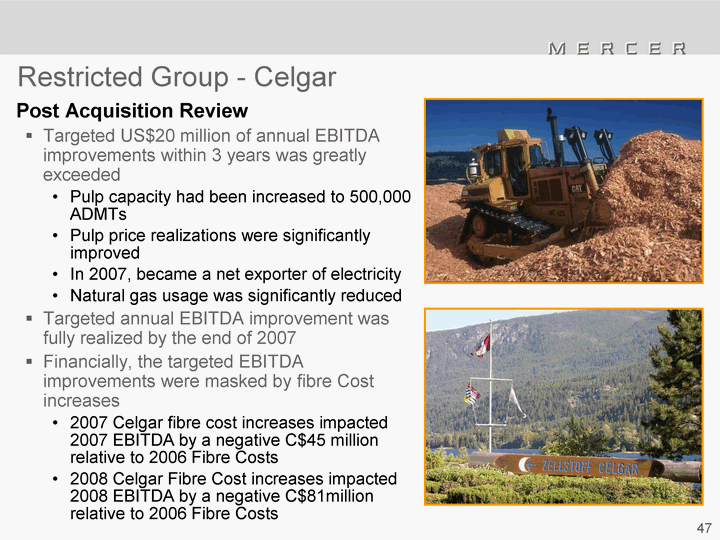
| Restricted Group - Celgar Post Acquisition Review Targeted US$20 million of annual EBITDA improvements within 3 years was greatly exceeded Pulp capacity had been increased to 500,000 ADMTs Pulp price realizations were significantly improved In 2007, became a net exporter of electricity Natural gas usage was significantly reduced Targeted annual EBITDA improvement was fully realized by the end of 2007 Financially, the targeted EBITDA improvements were masked by fibre Cost increases 2007 Celgar fibre cost increases impacted 2007 EBITDA by a negative C$45 million relative to 2006 Fibre Costs 2008 Celgar Fibre Cost increases impacted 2008 EBITDA by a negative C$81million relative to 2006 Fibre Costs |
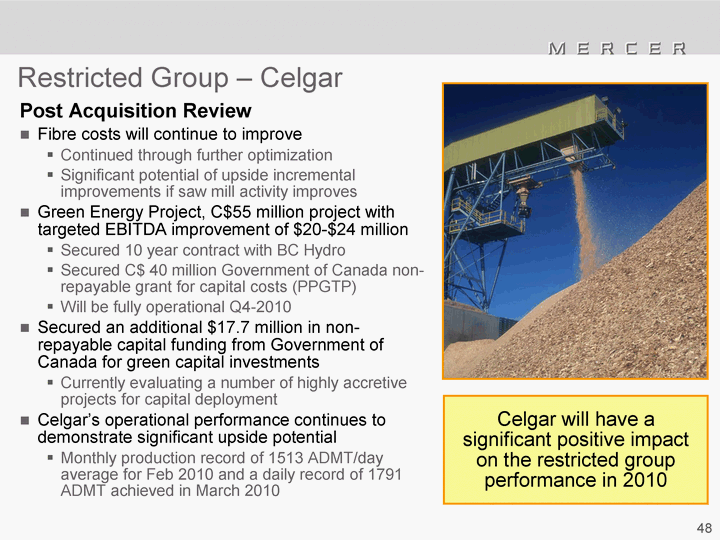
| Celgar will have a significant positive impact on the restricted group performance in 2010 Restricted Group - Celgar Post Acquisition Review Fibre costs will continue to improve Continued through further optimization Significant potential of upside incremental improvements if saw mill activity improves Green Energy Project, C$55 million project with targeted EBITDA improvement of $20-$24 million Secured 10 year contract with BC Hydro Secured C$ 40 million Government of Canada non- repayable grant for capital costs (PPGTP) Will be fully operational Q4-2010 Secured an additional $17.7 million in non- repayable capital funding from Government of Canada for green capital investments Currently evaluating a number of highly accretive projects for capital deployment Celgar's operational performance continues to demonstrate significant upside potential Monthly production record of 1513 ADMT/day average for Feb 2010 and a daily record of 1791 ADMT achieved in March 2010 |

| Operating Performance Notes: Celgar acquisition closed in February 2005, Stendal start up was September 2004, production includes pulp produced from those dates. In 2009, Rosenthal underwent an extended maintenance shut-down, lowering total production. Also in 2009, Celgar was forced to curtail production due to rail car shortages from extreme weather conditions CAGR: 4.2% CAGR: -0.3% CAGR: 6.7% CAGR: 4.7% |
